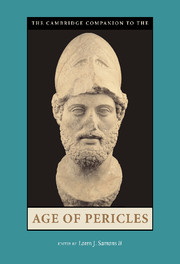Book contents
- Frontmatter
- Introduction: Athenian History and Society in the Age of Pericles
- 1 Democracy and Empire
- 2 Athenian Religion in the Age of Pericles
- 3 The Athenian Economy
- 4 Warfare in Athenian Society
- 5 Art and Architecture
- 6 Other Sorts: Slaves, Foreigners, and Women in Periclean Athens
- 7 Drama and Democracy
- 8 The Bureaucracy of Democracy and Empire
- 9 Plato’s Sophists, Intellectual History after 450, and Sokrates
- 10 Democratic Theory and Practice
- 11 Athens and Sparta and the Coming of the Peloponnesian War
- Conclusion: Pericles and Athens
- Bibliography
- Index
5 - Art and Architecture
Published online by Cambridge University Press: 28 March 2009
- Frontmatter
- Introduction: Athenian History and Society in the Age of Pericles
- 1 Democracy and Empire
- 2 Athenian Religion in the Age of Pericles
- 3 The Athenian Economy
- 4 Warfare in Athenian Society
- 5 Art and Architecture
- 6 Other Sorts: Slaves, Foreigners, and Women in Periclean Athens
- 7 Drama and Democracy
- 8 The Bureaucracy of Democracy and Empire
- 9 Plato’s Sophists, Intellectual History after 450, and Sokrates
- 10 Democratic Theory and Practice
- 11 Athens and Sparta and the Coming of the Peloponnesian War
- Conclusion: Pericles and Athens
- Bibliography
- Index
Summary
Suppose that Sparta were to become deserted and only the temples and foundations of buildings remained, I think that future generations would, as time passed, find it very difficult to believe that the place had really been as powerful as it was reputed to be. . . If, on the other hand, the same thing were to happen to Athens, one would conjecture from what met the eye that the city had been twice as powerful as it actually is.
Thucydides (1.10.2)The monuments of fifth-century Athens, and its Acropolis (Figure 1) in particular, have come to embody the “Glory of Ancient Greece” to such a degree that Thucydides might be faulted for underestimation. While the knee-high remains of Sparta are today unimpressive, the Acropolis, a UNESCO World Heritage Site, averages over a million visitors annually. It appears constantly on travel brochures, postage stamps, restaurant menus, and olive oil containers, and even in less relevant contexts, such as Las Vegas casino chips and Japanese telephone cards. What accounts for the pervasiveness and continuing power of this imagery? Why are the art and architecture of fifth-century Athens so renowned?
There is no single answer, of course, but any explanation must take into account the extraordinary aesthetic quality of the monuments. Over half a millennium after their construction Plutarch wrote
The works of Pericles are even more admired – though built in a short time they have lasted for a very long time. For, in its beauty, each work was, even at that time, ancient, and yet, in its perfection, each looks even at the present time as if it were fresh and newly built. Thus there is a certain bloom of newness in each building and an appearance of being untouched by the wear of time. It is as if some ever-flowering life and unaging spirit had been infused into the creation of these works.
(Life of Pericles 13)- Type
- Chapter
- Information
- The Cambridge Companion to the Age of Pericles , pp. 125 - 152Publisher: Cambridge University PressPrint publication year: 2007
- 1
- Cited by

